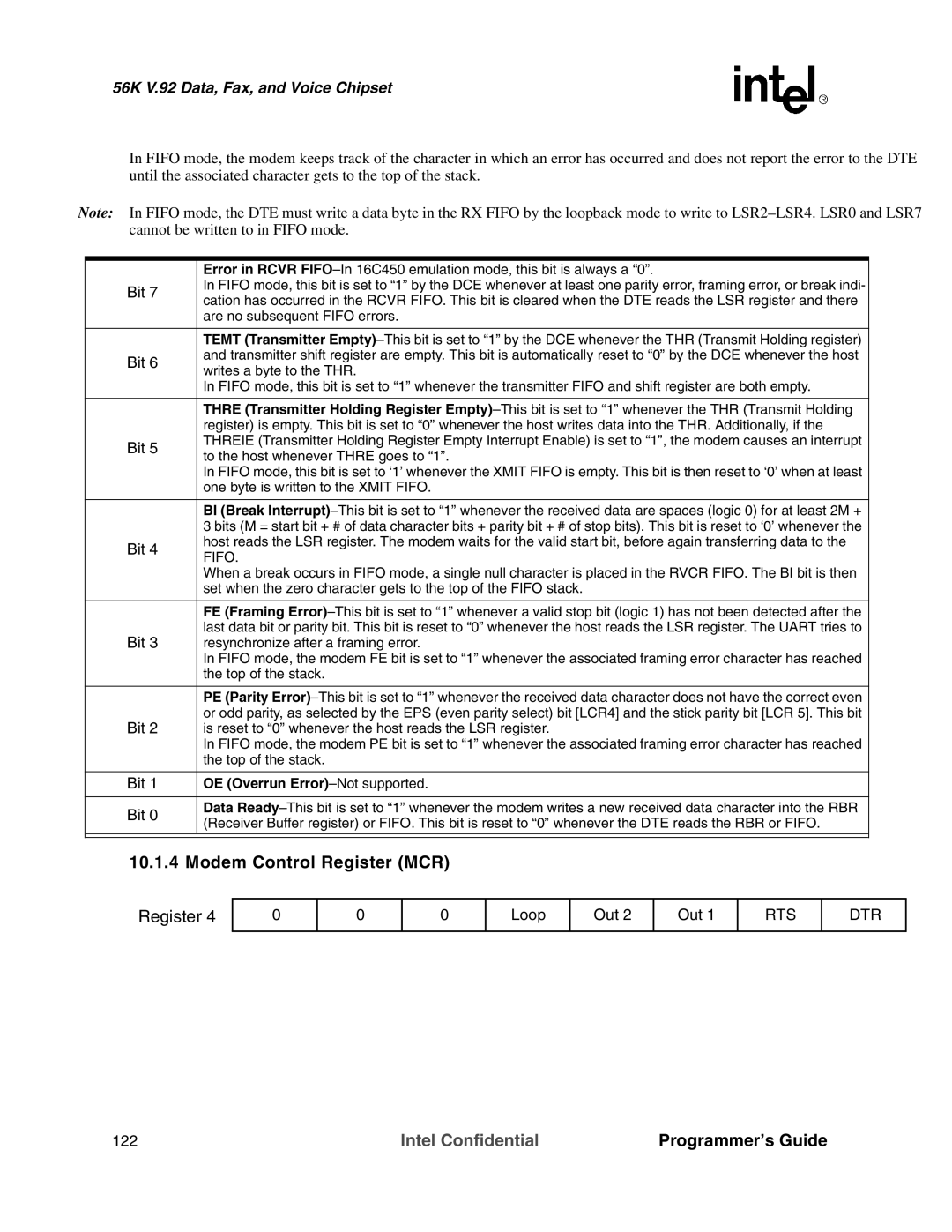
56K V.92 Data, Fax, and Voice Chipset
In FIFO mode, the modem keeps track of the character in which an error has occurred and does not report the error to the DTE until the associated character gets to the top of the stack.
Note: In FIFO mode, the DTE must write a data byte in the RX FIFO by the loopback mode to write to
| Error in RCVR | |
Bit 7 | In FIFO mode, this bit is set to “1” by the DCE whenever at least one parity error, framing error, or break indi- | |
cation has occurred in the RCVR FIFO. This bit is cleared when the DTE reads the LSR register and there | ||
| ||
| are no subsequent FIFO errors. | |
|
| |
| TEMT (Transmitter | |
Bit 6 | and transmitter shift register are empty. This bit is automatically reset to “0” by the DCE whenever the host | |
writes a byte to the THR. | ||
| ||
| In FIFO mode, this bit is set to “1” whenever the transmitter FIFO and shift register are both empty. | |
|
| |
| THRE (Transmitter Holding Register | |
| register) is empty. This bit is set to “0” whenever the host writes data into the THR. Additionally, if the | |
Bit 5 | THREIE (Transmitter Holding Register Empty Interrupt Enable) is set to “1”, the modem causes an interrupt | |
to the host whenever THRE goes to “1”. | ||
| ||
| In FIFO mode, this bit is set to ‘1’ whenever the XMIT FIFO is empty. This bit is then reset to ‘0’ when at least | |
| one byte is written to the XMIT FIFO. | |
|
| |
| BI (Break | |
| 3 bits (M = start bit + # of data character bits + parity bit + # of stop bits). This bit is reset to ‘0’ whenever the | |
Bit 4 | host reads the LSR register. The modem waits for the valid start bit, before again transferring data to the | |
FIFO. | ||
| ||
| When a break occurs in FIFO mode, a single null character is placed in the RVCR FIFO. The BI bit is then | |
| set when the zero character gets to the top of the FIFO stack. | |
|
| |
| FE (Framing | |
Bit 3 | last data bit or parity bit. This bit is reset to “0” whenever the host reads the LSR register. The UART tries to | |
resynchronize after a framing error. | ||
| In FIFO mode, the modem FE bit is set to “1” whenever the associated framing error character has reached | |
| the top of the stack. | |
|
| |
| PE (Parity | |
Bit 2 | or odd parity, as selected by the EPS (even parity select) bit [LCR4] and the stick parity bit [LCR 5]. This bit | |
is reset to “0” whenever the host reads the LSR register. | ||
| In FIFO mode, the modem PE bit is set to “1” whenever the associated framing error character has reached | |
| the top of the stack. | |
|
| |
Bit 1 | OE (Overrun | |
|
| |
Bit 0 | Data | |
(Receiver Buffer register) or FIFO. This bit is reset to “0” whenever the DTE reads the RBR or FIFO. | ||
| ||
|
| |
|
|
10.1.4 Modem Control Register (MCR)
Register 4
0
0
0
Loop
Out 2
Out 1
RTS
DTR
122 | Intel Confidential | Programmer’s Guide |
